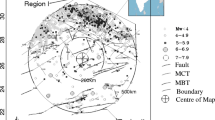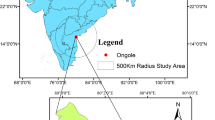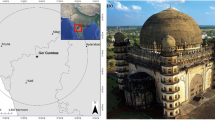Abstract
The objective of this paper was to develop the seismic hazard maps of Patna district considering the region-specific maximum magnitude and ground motion prediction equation (GMPEs) by worst-case deterministic and classical probabilistic approaches. Patna, located near Himalayan active seismic region has been subjected to destructive earthquakes such as 1803 and 1934 Bihar–Nepal earthquakes. Based on the past seismicity and earthquake damage distribution, linear sources and seismic events have been considered at radius of about 500 km around Patna district center. Maximum magnitude (M max) has been estimated based on the conventional approaches such as maximum observed magnitude (M obsmax ) and/or increment of 0.5, Kijko method and regional rupture characteristics. Maximum of these three is taken as maximum probable magnitude for each source. Twenty-seven ground motion prediction equations (GMPEs) are found applicable for Patna region. Of these, suitable region-specific GMPEs are selected by performing the ‘efficacy test,’ which makes use of log-likelihood. Maximum magnitude and selected GMPEs are used to estimate PGA and spectral acceleration at 0.2 and 1 s and mapped for worst-case deterministic approach and 2 and 10 % period of exceedance in 50 years. Furthermore, seismic hazard results are used to develop the deaggregation plot to quantify the contribution of seismic sources in terms of magnitude and distance. In this study, normalized site-specific design spectrum has been developed by dividing the hazard map into four zones based on the peak ground acceleration values. This site-specific response spectrum has been compared with recent Sikkim 2011 earthquake and Indian seismic code IS1893.

















Similar content being viewed by others
References
Abrahamson NA, Litehiser JJ (1989) Attenuation of vertical peak accelerations. Bull Seismol Soc Am 79:549–580
Abrahamson NA, Silva WJ (2007) Abrahamson & Silva NGA ground motion relation for the geometric mean horizontal component of peak and spectral ground motion parameters. Report, Pacific Earthquake Research Center, Berkeley
Abramowitz M, Stegun IA (1970) Handbook of mathematical functions, 9th edn. Dover Publication, New York
Aghabarati H, Tehranizadeh (2009) Near-source ground motion attenuation relationship for PGA and PSA of vertical and horizontal components. Bull Earthq Eng 7:609–635. doi:10.1007/s10518-009-9114-9
Akkar S, Bommer JJ (2010) Empirical equations for the prediction of PGA, PGV and spectral acceleration in Europe, the Mediterranean region and the Middle East. Seismol Res Lett 81:195–206
Algermissen ST, Perkins DM, Thenhaus PC, Hanson SL, Bender BL (1982) Probabilistic estimates of maximum acceleration and velocity in rock in the contiguous United States. Open-File Report 82–1033. U.S. Geological Survey, Washington, DC, p 99
Ambraseys NN, Douglas J (2004) Magnitude calibration of north Indian earthquakes. Geophys J Int 158:1–42
Ambraseys N, Douglas JS, Sarma K, Smit PM (2005) Equation for the estimation of strong ground motions from shallow crustal earthquakes using data from Europe and the Middle East: horizontal peak ground acceleration and the spectral acceleration. Bull Earthq Eng 3:1–53
Anbazhagan P, Vinod JS, Sitharam TG (2009) Probabilistic seismic hazard analysis for Bangalore. Nat Hazards 48:145–166
Anbazhagan P, Vinod JS, Sitharam TG (2010) Evaluation of seismic hazard parameters for Bangalore region in South India. Disaster Adv 3(3):5–13
Anbazhagan P, Kumar A, Sitharam TG (2012) Seismic site classification and correlation between standard penetration test N value and shear wave velocity for Lucknow city in Indo-Gangetic basin. Pure Appl Geophys 170(2013):299–318. doi:10.1007/s00024-012-0525-1
Anbazhagan P, Kumar A, Sitharam TG (2013a) Ground motion prediction equation considering combined data set of recorded and simulated ground motions. Soil Dyn Earthq Eng 53:92–108
Anbazhagan P, Smitha CV, Kumar A, Chandran D (2013b) Seismic hazard assessment of NPP site at Kalpakkam, Tamil Nadu, India. Nucl Eng Des 259:41–64
Anbazhagan P, Smitha CV, Abhishek Kumar (2014) Representative seismic hazard map of Coimbatore, India. Eng Geol 171:81–95
Anbazhagan P, Bajaj K, Moustafa SSR, Al-Arifi NSN (2015) Maximum magnitude estimation considering the regional rupture character. J Seismol. http://springer.longhoe.net/article/10.1007%2Fs10950-015-9488-x (published online)
Atkinson GM, Boore DM (2003) Empirical ground-motion relations for subduction-zone earthquakes and their applications to Cascadian and other regions. Bull Seismol Soc Am 93:1703–1717
Atkinson GM, Boore DM (2006) Earthquake ground-motion prediction equations for eastern North America. Bull Seismol Soc Am 96:2181–2205
Banghar AR (1991) Mechanism solution of Nepal–Bihar earthquake of August 20, 1988. J Geol Soc India 37:25–30
Baruah S, Gogoi NK, Erteleva Q, Aptikaev F, Kayal JR (2009) Ground motion parameters of Shillong plateau: one of the most seismically active zones of Northeastern India. Earthq Sci 22:283–291
Bhatia SC, Ravi MK, Gupta HK (1999) A probabilistic seismic hazard map of India and adjoining regions. Ann Geofis 42:1153–1164
Bommer JJ, Scherbaum F, Bungum H, Cotton F, Sabetta F, Abrahamson NA (2005) On the use of logic trees for ground-motion prediction equations in seismic-hazard analysis. Bull Seismol Soc Am 95:377–389
Bommer JJ, Douglas J, Scherbaum F, Cotton F, Bungum H, Fäh D (2010) On the selection of ground-motion prediction equations for seismic hazard analysis. Seismol Res Lett 81(5):783–793
Boore DM, Atkinson GM (2008) Ground-Motion Prediction Equations for the average horizontal component of PGA, PGV and 5% damped PSA at spectral periods between 0.01 and 10.0 s. Earthq Spectra 24(1):99–138
Bormann P, Liu R, Ren X, Gutdeutch R, Kaiser D, Castellaro S (2007) Chinese national network magnitudes, their relation to NEIC magnitudes and recommendations for new IASPEI magnitude standard. Bull Seismol Soc Am 95:58–74
Campbell KW (1997) Empirical near-source attenuation relationships for horizontal and vertical components of peak ground acceleration, peak ground velocity and pseudo-absolute acceleration response spectra. Seismol Res Lett 68(1):154–179
Campbell KW, Bozorgnia Y (2006) Next generation attenuation relation (NGA) Empirical ground motion models: can they be used for Europe. In: Proceedings of first European conference on earthquake engineering and seismology, Geneva, Switzerland, paper no. 458
Campbell KW, Bozorgnia Y (2008) NGA ground motion model for the geometric mean horizontal component of PGA, PGV, PGD and 5 % damped linear elastic response spectra for period ranging from 0.01 to 10 s. Earthq Spectra 24:139–171
Castellaro S, Mulargia F, Kagan YY (2006) Regression problems for magnitudes. Geophys J Int 165:913–930
Cornell CA (1968) Engineering seismic rick analysis. Bull Seismol Soc Am 58:1583–1606
Cotton F, Scherbaum F, Bommer JJ, Bungum H (2006) Criteria for selecting and adjusting ground-motion models for specific target regions: application to Central Europe and rock sites. J Seismol 10:137–156
Das S, Gupta ID, Gupta VK (2006) A probabilistic seismic hazard analysis of Northeast India. Earthq Spectra 22:1–27
Dasgupta S, Mukhopadyay M, Nandy DR (1987) Active transverse features in the central portion of the Himalaya. Tectonophysics 136(1987):255–264
Dasgupta S, Sengupta P, Mondal A, Fukuoka M (1993) Mineral chemistry and reaction textures in metabasites from the Eastern Ghats belt, India and their implications. Miner Mag 57:113–120
Davis SD, Frohlich C (1991) Single-link cluster analysis, synthetic earthquake catalogs and aftershock identification. Geophys J Int 104:289–306
Delavaud E, Scherbaum F, Kuehn N, Allen T (2012) Testing the global applicability of ground-motion prediction equations for active shallow crustal regions. Bull Seism Soc Am 102(2):702–721
Delavaud E, Scherbaum F, Kuehn N, Riggelsen C (2009) Information-theoretic selection of ground-motion prediction equations for seismic hazard analysis: an applicability study using Californian data. Bull Seismol Soc Am 99:3248–3263
Dewey JF, Bird JM (1970) Mountain belts and the new global tectonics. J Geophys Res 75(14):2625–2647
Douglas J (2010) Consistency of ground-motion predictions from the past four decades. Bull Earthq Eng 8:1515–1526
Douglas J, Mohais R (2009) Comparing predicted and observed ground motions from subduction earthquakes in the Lesser Antilles. J Seism 13(4):577–587
EERI committee on seismic risk (1984) Glossary of terms for probabilistic seismic risk and hazard analysis. Earthq Spectra 1:33–36
Frankel A (1995) Map** seismic hazard in the central eastern United States. Seismol Res Lett 66(4):8–21
Gansser A (1964) Geological history of Himalayan. Geology of the Himalayas, Wiley, Switzerland, pp 235–245
Gardner JK, Knopoff L (1974) Is the sequence of earthquakes in southern California, with aftershocks removed, poissonian? Bull Seismol Soc Am 64(5):1363–1367
Grünthal G (1998) European macroseismic scale 1998. Cahiers du Centre EuropéendeGéodynamiqueet de Séismologie, vol 15, Luxembourg
GSI (2000) Eastern Nepal Himalaya and Indo-Gangetic Plains of Bihar. In: Narula PL, Acharyya SK, Banerjee J (eds) Seismotectonics Atlas of India and its environs. Geological Survey of India, India, pp 26–27
Gupta ID (2010) Response spectral attenuation relations for inslab earthquakes in Indo-Burmese subduction zone. Soil Dyn Earthq Eng 30:368–377
Gutenberg B, Richter CF (1956) Earthquake magnitude, intensity, energy and acceleration. Bull Seismol Soc Am 46:105–145
Hintersberger E, Scherbaum F, Hainzl S (2007) Update of likelihood-based ground motion model selection for seismic hazard analysis in western central Europe. Bull EarthqEng 5:1–16
Idriss IM (2008) An NGA empirical model for estimating the horizontal spectral values generated by shallow crustal earthquakes. Earthq Spectra 16:363–372
IS 1893 (2002) Indian standard criteria for earthquake resistant design of structures, part 1-general provisions and buildings. Bureau of Indian Standards, New Delhi
Joshi GC, Sharma ML (2008) Uncertainties in the estimation of M max. J Earth Syst Sci 117(S2):671–682
Kaklamanos J, Baise LG (2011) Model validations and comparisons of the next generation attenuation of ground motions (NGA–West) project. Bull Seism Soc Am 101(1):160–175
Kanno T, Narita A, Morikawa N, Fujiwara H, Fukushima Y (2006) A new attenuation relation for strong ground motion in Japan based on recorded data. Bull Seismol Soc Am 96:879–897
Khattri KN (1987) Great earthquakes, seismicity gaps and potential for earthquakes along the Himalayan plate boundary. Tectonophysics 38:79–92
Kijko A, Sellevoll MA (1989) Estimation of earthquake hazard parameters from incomplete data files. Part I, utilization of extreme and complete catalogues with different threshold magnitudes. Bull Seismol Soc Am 79:645–654
Kolathayar S, Sitharam TG, Vipin KS (2012) Deterministic seismic hazard microzonation of India. J Earth Syst Sci 121:1351–1364
Kumar S (2012) Seismicity in the NW Himalaya India: fractal dimension, b-value map** and temporal variation for hazard evaluation. Geosci Res 3(1):83–87
Kumar A, Anbazhagan P, Sitharam TG (2013) Seismic hazard analysis of Lucknow considering local and active seismic gaps. Nat Hazards 69:327–350. doi:10.1007/s11069-0.13-0712-0
Lai CG, Menon A, Corigliano M, Ornthamarrath, Sanchez HL, Dodagoudar GR (2009) Probabilistic seismic hazard assessment and stochastic site response analysis at the archaeological site of Kancheepuram in southern India. Research Report EUCENTRE 2009/01, IUSS Press, Pavia, ISBN 978-88-6198-037-2:250
Lin PS, Lee CH (2008) Ground-Motion Attenuation relationship for subduction-zone earthquakes in Northeastern Taiwan. Bull Seismol Soc Am 98(1):220–240
Mahajan AK, Thakur VC, Sharma ML, Chauhan M (2010) Probabilistic seismic hazard map of NW Himalaya and its adjoining area, India. Nat Hazards 53:443–457
Malhotra PK (2006) Smooth spectra of horizontal and vertical ground motions. Bull Seismol Soc Am 96(2):506–518
Mohindra R, Parkash B, Prasad J (1992) Historical geomorphology and pedology of the Gandak Megafan, Middle Gangetic Plains, India. Earth Surf Process Land 17:643–662
Molchan G, Dmitrieva O (1992) Aftershock identification: methods and new approaches. Geophys J Int 109:501–516
Nath SK, Thingbaijam KKS (2011) Peak ground motion predictions in India: an appraisal for rock sites. J Seismol 15:295–315
Nath SK, Thingbaijam KKS (2012) Probabilistic seismic hazard assessment of India. Seismol Res Lett 83:135–149
Nath SK, Vyas M, Pal I, Sengupta P (2005) A hazard scenario in the Sikkim Himalaya from seismotectonics spectral amplification source parameterization and spectral attenuation laws using strong motion seismometry. J Geophys Res 110:1–24
Nath SK, Raj A, Thingbaijam KKS (2009) Kumar A (2009) Ground motion synthesis and seismic scenario in Guwahati city, a stochastic approach. Seismol Res Lett 80(2):233–242
NDMA (2010) Development of probabilistic seismic hazard map of India. Technical report by National Disaster Management Authority, Government of India, New Delhi
Parvez IA, Vaccari F, Panza GF (2003) A deterministic seismic hazard map of India and adjacent areas. Geophys J Int 155:489–508
Reasenberg P (1985) Second-order moment of central California seismicity 1969–1982. J Geophys Res 90:5479–5495
Sabetta F, Lucantoni A, Bungum H, Bommer JJ (2005) Sensitivity of PSHA results to ground motion prediction relations and logic-tree weights. Soil Dyn Earthq Eng 25:317–329
Savage WU (1972) Microearthquake clustering near Fairview Peak, Nevada, and in the Nevada seismic zone. J Geophys Res 77(35):7049–7056
Scherbaum F, Cotton F, Smit P (2004) On the use of response spectral reference data for the selection and ranking of ground-motion models for seismic hazard analysis in regions of moderate seismicity: the case of rock motion. Bull Seismol Soc Am 94:1–22
Scherbaum F, Bommer JJ, Bungum H, Cotton F, Abrahamson NA (2005) Composite ground-motion models and logic trees: methodology, sensitivities, and uncertainties. Bull Seismol Soc Am 95:1575–1593
Scherbaum F, Delavaud E, Riggelsen C (2009) Model selection in seismic hazard analysis: an information theoretic perspective. Bull Seismol Soc Am 99:3234–3247
Scordilis EM (2006) Empirical global relations converting MS and mb to moment magnitude. J Seismol 10:225–236
SEISAT (2000) Seismotectonic Atlas of India and its environs. Geological Survey of India, India
Sharma ML (1998) Attenuation relationship for estimation of peak ground horizontal acceleration using data from strong motions arrays in India. Bull Seismol Soc Am 88:1063–1069
Sharma ML, Bungum H (2006) New strong ground motion spectral acceleration relation for the Himalayan region. In First European conference on earthquake engineering and seismology, p 1459
Sharma ML, Douglas J, Bungum H, Kotadia J (2009) Ground-motion prediction equations based on data from Himalayan and Zagros regions. J Earthq Eng 13:1191–1210
Singh RP, Aman A, Prasad YJJ (1996) Attenuation relations for strong ground motion in the Himalayan region. Pure appl Geophys 147:161–180
Sinha R, Tandon SK, Gibling MR, Bhattarcharjee PS, Dasgupta AS (2005) Late quaternary geology and alluvial stratigraphy of the Ganga basin. Himal Geol 26(1):223–340
Spudich P, Joyner WB, Lindh AG, Boore DM, Margaris BM, Fletcher JB (1999) SEA99: a revised ground motion prediction relation for use in Extensional tectonic regions. Bull Seism Soc Am 89(5):1156–1170
Sreevalsa K, Sitharam TG, Vipin KS (2011) Spatial variation of seismicity parameters across India and adjoining area. Nat Hazards. doi:10.1007/s11069-011-9898-1
Stepp JC (1972) Analysis of completeness of the earthquake sample in the Puget Sound area and its effect on statistical estimates of earthquake hazard. Proceeding of the International conference on microzonation, vol 2. Seattle, USA, pp 897–910
Stiphout VT, Zhuang J, Marsan D (2010) Seismicity declustering, community online resource for statistical seismicity analysis. http://www.corssa.org. Accessed 14 Jan 2014
Strasser FO, Abrahamson NA, Bommer JJ (2009) Sigma: issues, insights, and challenges. Seismol Res Lett 80(1):40–56
Stromeyer D, Grunthal G, Wahlstrom R (2004) Chi square regression for seismic strength parameter relations, and their uncertainty with application to an M w based earthquake catalogue for central, northern and north-western Europe. J Seismol 8:143–153
Takahashi T, Saiki T, Okada H, Irikura K, Zhao JX, Zhang J, Thoi HK, Somerville PG, Fukushima Y, Fukushima Y (2004) Attenuation models for response spectra derived from Japanese strong-motion records accounting for tectonic source types. 13th world conference of earthquake engineering, Vancouver, B.C., Canada, paper 1271
Thingbaijam KKS, Nath SK, Yadav A, Raj A, Walling MY, Mohanty WK (2008) Recent seismicity in Northeast India and its adjoining region. J Seismol 12:107–123
Uhrhammer RA (1986) Characteristics of northern and central California seismicity. Earthq Notes 1:21
Valdiya KS (1976) Himalayan transverse faults and their parallelism with subsurface structures of north Indian plains. Tectonophysics 32:352–386
Wallace K, Bilham R, Blume F, Gaur VK, Gahalaut V (2006) Geodetic constraints on the Bhuj 2001 earthquake and surface deformation in the Kachchh Rift basin. Geophys Res Lett 33:L10301. doi:10.1029/2006GL025775
Wells DL, Coppersmith KJ (1994) New empirical relationships among magnitude, rupture length, rupture width, rupture area, and surface displacement. Bull Seismol Soc Am 4(84):975–1002
Wiemer S, Wyss M (1994) Seismic quiescence before the landers (M = 7.5) and big bear (M = 6.5) 1992 earthquakes. Bull Seismol Soc Am 84:900–916
Wiemer S, Wyss M (1997) Map** the frequency-magnitude distribution in asperities: an improved technique to calculate recurrence times? J Geophys Res 102:15115–15128
Woessner J, Stefan W (2005) Assessing the quality of earthquake catalogues: estimating the magnitude of completeness and its uncertainty. Bull Seism Soc Am 95(2):684–698
Youngs RR, Chiou SJ, Silva WJ, Humphrey JR (1997) Strong ground motion relationship for subduction earthquakes. Seismol Res Lett 68:58–73
Zhao JX, Zhang J, Asano A, Ohno Y, Oouchi T, Takahashi T, Ogawa H, Irikura K, Thio HK, Somerville PG, Fukushima Y, Fukushima Y (2006) Attenuation relations of strong ground motion in Japan using site classification based on predominant period. Bull Seismol Soc Am 96:898–913
Author information
Authors and Affiliations
Corresponding author
Electronic supplementary material
Below is the link to the electronic supplementary material.
Rights and permissions
About this article
Cite this article
Anbazhagan, P., Bajaj, K. & Patel, S. Seismic hazard maps and spectrum for Patna considering region-specific seismotectonic parameters. Nat Hazards 78, 1163–1195 (2015). https://doi.org/10.1007/s11069-015-1764-0
Received:
Accepted:
Published:
Issue Date:
DOI: https://doi.org/10.1007/s11069-015-1764-0




